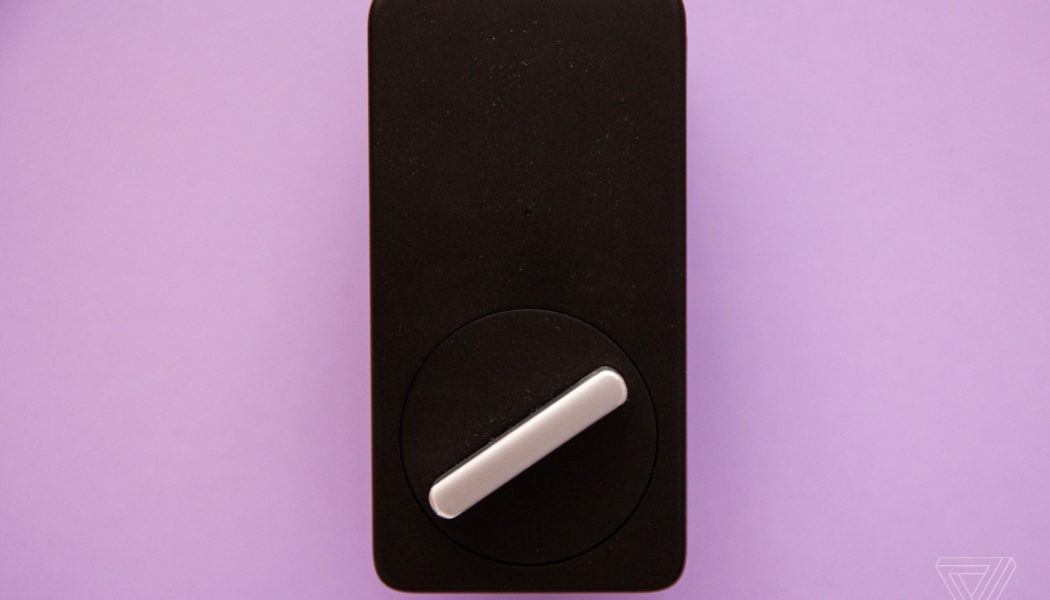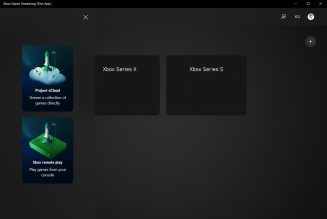The $99 SwitchBot Lock is the first smart door lock I’ve tested that doesn’t replace any part of your existing lock. Instead, it attaches to the back of your door over the top of the thumb turn. This removes a major pain point of smart locks: an involved installation. But the SwitchBot Lock is really odd looking — my husband literally stopped in his tracks and said, “What is that thing?” I had a similar reaction when I first saw it and was wholly unconvinced this large piece of black plastic would have the power to unlock my deadbolt.
I was surprised to discover that the SwitchBot Lock moves that thumb turn just as well as I can, and it stayed firmly put during my two weeks of testing, despite being attached solely by double-sided sticky tape. (No word yet on long-term durability, but it looks promising so far).
The downsides are that it’s not very smart and it’s missing a few key features (haha). You also need around $70 worth of accessories to add smart home control and a keypad. This puts it closer in price to more elegant-looking solutions, such as the $230 August Wi-Fi Smart Lock, which needs a bit more work to install but doesn’t leave you with a honking great piece of plastic on your door.
How we review and rate products
The SwitchBot Lock is a retrofit Bluetooth-powered smart door lock that can lock and unlock your door using the SwitchBot app on a smartphone or Apple Watch. (It’s not Home Key compatible). It attaches to your door using 3M VHB tape and uses a small plastic grabber to hold on to and turn the lock’s thumb turn.
That grabber can turn anything. Videos in Amazon reviews show it even turning a key, making this an excellent solution for people with nontraditional door locks and multipoint locks who can’t get any other smart lock to work (see a list here). It’s cleverly engineered with shifting base plates that prevent the lock from twisting itself off while turning the lock.
This is SwitchBot’s thing: making regular devices smart. They have a little bot that presses your light switch for you and a robot that crawls along your curtain rod to open and close the curtains. This one is a robot hand for your door lock. It comes with three different-sized adapters, so you can find the right fit for your setup. The SwitchBot Lock doesn’t remove any function — you can still use your key, and you can still turn the deadbolt manually; it just adds the ability to use your phone or watch as your key.
:no_upscale()/cdn.vox-cdn.com/uploads/chorus_asset/file/23970646/226160_SWITCHBOT_DOOR_LOCK_PHO_jtuohy_0009.jpg)
There are a total of seven ways to control the door lock: your key, the smartphone / Apple Watch app, NFC tags using your phone, a key code using a keypad, a fingerprint reader, an NFC keycard, and smart home / voice control. That’s a lot of options — although only the first three work out of the box.
:no_upscale()/cdn.vox-cdn.com/uploads/chorus_asset/file/23970644/226160_SWITCHBOT_DOOR_LOCK_PHO_jtuohy_0007.jpg)
For the keycard, keypad, or fingerprint entry, you’ll need one of SwitchBot’s two Bluetooth keypads. These attach with double-sided tape (or screws if you prefer). I tested the fingerprint version, which costs $60, and it worked quickly and reliably.
The non-fingerprint version is only $30, but fingerprint access is my favorite way to use a smart door lock. The keypads also work with NFC keycards. (One is supplied and you can buy a three-pack for $15.) Although, if you have a keypad, I don’t see a need for a keycard, as you can dole out permanent, temporary, and one-time codes to anyone who needs access. Annoyingly, six digits is the minimum here, which is a lot of digits.
If you don’t go for the extra keypads, another unlock option is using the two NFC tags that come with the lock. You can pair those to your phone to lock or unlock the door with a tap of your phone. But you have to use two tags: one to lock and one to unlock. Sticking two white pieces of plastic on your door does not improve the overall look here, and if you have your phone out already, using the iOS or Android lock screen widget is almost as fast.
The SwitchBot does work with Amazon Alexa, Google Home, and Siri Shortcuts (but not HomeKit), so you can use voice commands to lock and unlock the door and add the lock into smart home Routines (Alexa and Google only).
But you need a $40 SwitchBot Hub Mini to connect the lock to Wi-Fi and make these integrations; the lock itself communicates over Bluetooth. You also need the hub to control the lock or check its status when you’re not at home using the SwitchBot app. The hub works with all of SwitchBot’s gadgets but needs to be installed near the lock.
Operating the SwitchBot with an Apple Watch over Bluetooth.
I installed the SwitchBot Lock on my back door, which is a main entryway to our house. It leads into our mudroom from our garage and gets a lot of foot traffic. The fingerprint reader and keypad made it easy for my children to use the lock — no need to download an app. Without those, though, there is not an easy way for a kid without a smartphone to access the door.
I was also disappointed that the notifications when the door is unlocked didn’t show which code or fingerprint was used. This is a common feature on other smart locks and one I personally use to help keep track of my older kids’ comings and goings when I’m at work. I could check the log in the app to see who unlocked it, though.
Locking and unlocking are fast when controlling it with the keypad, but the phone app takes over five seconds to connect — very irritating if you’re standing in the rain. The Apple Watch connects more quickly, and if you didn’t have a keypad, is the easiest way to control the lock. All these interactions are over Bluetooth, so you must stand by the lock. To control it remotely with the app or voice control, you need the hub.
:no_upscale()/cdn.vox-cdn.com/uploads/chorus_asset/file/23970641/226160_SWITCHBOT_DOOR_LOCK_PHO_jtuohy_0003.jpg)
Setup and installation were quick, under 5 minutes in all. This is one of the lock’s biggest selling points, but it also wasn’t entirely straightforward. There’s a bit of lining up to do to make sure the lock will turn before you tape it to the door, and you need to use a small screwdriver (supplied) to adjust the spacing of the lock. Cleverly, it attaches in any direction, vertically or horizontally, so you can fit it around your door handle. It also comes with a magnet to sense when the door is open or closed, although I could still lock it remotely while it was wide open without any alert or notification.
The SwitchBot app is basic. There’s no way to create schedules to lock or unlock the door at a set time of day, and the auto-lock feature was very spotty. It only worked with both the “Lock after a set period of time” and the “Re-lock if the door has been unlocked but not opened” toggles on, and even then, it was unreliable. This seems like a software bug that may get fixed. But it did mean I had to get my phone out to lock the door (there are iOS and Android lock screen widgets to make this quicker), use the Apple Watch app, or use my key. When I added the keypad, though, I could hit a button to lock it.
There are some useful notification options, including when the door is locked, if the door has been left unlocked, and if it’s been left ajar after a certain amount of time. Notifications require the hub to work, and really, they should just sell this with the hub. It definitely makes it a better smart lock. With the hub, I could connect to Alexa and add the lock to an Alexa Routine that automatically locked it every night at sunset.
:no_upscale()/cdn.vox-cdn.com/uploads/chorus_asset/file/23970642/226160_SWITCHBOT_DOOR_LOCK_PHO_jtuohy_0004.jpg)
The SwitchBot Lock a good option for renters who can’t change their door lock at all or for those who can’t or won’t remove any part of their existing deadbolt. It does need to stick to the doorframe using a heavy-duty adhesive, which will likely take some paint with it if you ever remove it. Similar retrofit options from August, Wyze, and Bosma require removing the rear deadbolt, and they all cost over $100.
But its smart features are limited to controlling the lock locally with your phone, Apple Watch, or existing key. When you add in the Wi-Fi hub, you get away-from-home control and more useful smart home integrations, but only with Google Home and Alexa; there’s no HomeKit support and limited IFTTT integration. (The lock is only a trigger, not an action.)
If you also add in the keypad — especially the fingerprint one — this becomes a much more useful proposition, but then you’re knocking on $170, closer to the price of less ugly options with better smarts that don’t require all this extra equipment (but do require removing some or all of your door lock). These include the August Wi-Fi Smart Lock plus Keypad and the Eufy Smart Lock Touch with Wi-Fi (fingerprint reader and keypad in one but a full lock replacement).
The biggest benefit of this lock is its versatility. You can even use two on one door to deal with multipoint locking. Its ability to grab pretty much any type of locking mechanism, including a key, means it may be the only smart solution that works for your door.
Photography by Jennifer Pattison Tuohy / The Verge









